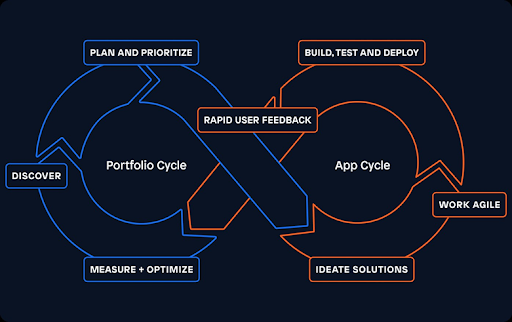Intuitive, low-code development systems can enable the creation and customization of basic tools and dashboards to a broader set of employee skill sets, reducing the cost and time to deploy.
Learning Objectives
- Learn how low-code development allows employees that are not developers to participate in creating or customizing software.
- Accelerate development timelines for developers through low-code architectures.
- Understand how faster development and deployment saves costs and time.
Low-code development insights
- Low-code development empowers industrial organizations to rapidly build and deploy applications, reducing downtime, enhancing flexibility and enabling seamless scaling through reusable, preconfigured components.
- By leveraging “dockerized” applications running on-premise, businesses can achieve near real-time data processing, minimize reliance on specialized developers and adapt quickly to evolving operational demands.
In a competitive landscape, industrial organizations face constant
pressure to enhance efficiency, reduce downtime and adapt to evolving business
demands. The need for process agility to meet shifting customer requirements is
also increasing.
Traditional software development approaches often struggle to keep
pace with these requirements due to high costs, long development cycles and the
need for specialized skills. Low-code applications, however, offer a compelling
alternative.
By leveraging a low-code development environment with “dockerized”
applications deployed and executed on-premise, industrial organizations can
unlock significant cost and time savings. Dockerization — also known as
containerization in coding parlance — is the process of packaging software,
including its dependencies, into a standard, self-sufficient container. A
Docker container is a lightweight, portable and executable package that
includes everything needed to run an application, such as code, runtime, system
tools, libraries and settings.
Low-code development allows users to create applications with
minimal coding, allowing industrial facilities to speed and simplify the
development process.
How
low-code development reduces downtime, enables flexibility
Traditional software development in industrial environments often
requires extensive time and resources, making it difficult to adapt to changing
business needs. Low-code development platforms introduce a new level of
flexibility by allowing organizations to deploy multiple instances of
applications across several devices.
Additionally, these applications can forward data to the cloud
when necessary, while maintaining critical functions on-premise. With features
such as drag-and-drop functionality, an intuitive visual user interface and
model-driven development, low-code platforms empower professional developers as
well as nontechnical users to build and customize applications efficiently.
This democratization of software development enables departments
outside of information technology to participate in application development,
ensuring faster adaptation to operational changes without relying solely on
specialized developers.
One significant issue with deploying custom software to improve
operations or dynamically change processes is the associated downtime. Every
minute of unplanned downtime can result in substantial financial losses.
Low-code applications address this issue by enabling custom applications to be
created and deployed quickly and scaled dynamically.
Normal operational downtime is also reduced if low-code
development applications are created for data collection and predictive
maintenance at the shop floor level with real-time dashboarding and local data
integration, allowing operators and decision-makers to monitor equipment status
and production metrics instantaneously. This proactive approach to maintenance
and monitoring significantly reduces unplanned downtime, improving operational
efficiency.
Agile scaling
with low-code development
Industrial settings often require custom software solutions to
meet changing customer demands or evolving production goals. Expensive
consultants and long lead times have plagued custom software development for
industrial applications for years. Low-code applications offer a solution by
enabling quick deployment and modification of applications.
Figure 2: Low-code development enables agility in automation
development. Courtesy: Siemens
With preconfigured modules, templates, connectors and reusable
elements, low-code applications allow organizations to develop solutions with
greater efficiency. This means businesses can fast-track development cycles and
deploy applications while ensuring production processes can be switched
seamlessly when required.
The ability to extend application features and deploy multiple
dockerized copies quickly enables businesses to scale their operations without
incurring excessive costs. This scalability is a crucial benefit of low-code
applications in industrial environments. Low-code applications ensure
consistent quality across multiple deployments by relying on easily
customizable, reusable components that have been pre-tested for performance and
security.
Furthermore, these applications support continuous delivery,
allowing organizations to implement improvements and updates with minimal disruption.
This scalability not only reduces software development costs but also enhances
long-term operational efficiency.
Skill
gaps addressed by low-code development
One of the biggest challenges facing industrial human resources
departments today is the shortage of skilled developers. Low-code development
platforms make application development accessible to a broader range of
employees with intuitive visual interfaces and model-driven development.
Individuals with limited coding experience can contribute to application
creation and customization and experienced developers can rapidly prototype and
deploy solutions.
Figure 3: Visualized elements replace walls of code, enabling
quick understanding of process changes. Courtesy: Siemens
By empowering existing talent to build and deliver applications
faster, low-code platforms reduce the reliance on outsourced developers or
consultants. This allows employees to customize solutions that meet their
departments’ specific needs and look to internal or external development
resources for only the most complex needs. This not only accelerates
development timelines but also fosters better collaboration and decision-making
among cross-functional teams.
The adoption of low-code applications in industrial settings is a
game-changer for organizations seeking to reduce costs, minimize downtime,
enhance flexibility and scale their operations efficiently. By leveraging
dockerized applications that operate on-premise, businesses can eliminate cloud
latency and achieve near real-time data processing, leading to improved
operational performance.
Low-code platforms enable rapid application development, allowing
industrial organizations to switch processes faster, adapt to changing demands
and empower their workforce with accessible development tools.
With preconfigured, reusable components, these applications
offer long-term cost savings while maintaining high performance and security
standards. As the industrial sector continues to evolve, the ability to deploy
and modify applications is increasingly essential. Low-code development
provides a strategic competitive advantage, ensuring that businesses remain
agile and competitive in an ever-changing landscape.














No comments:
Post a Comment